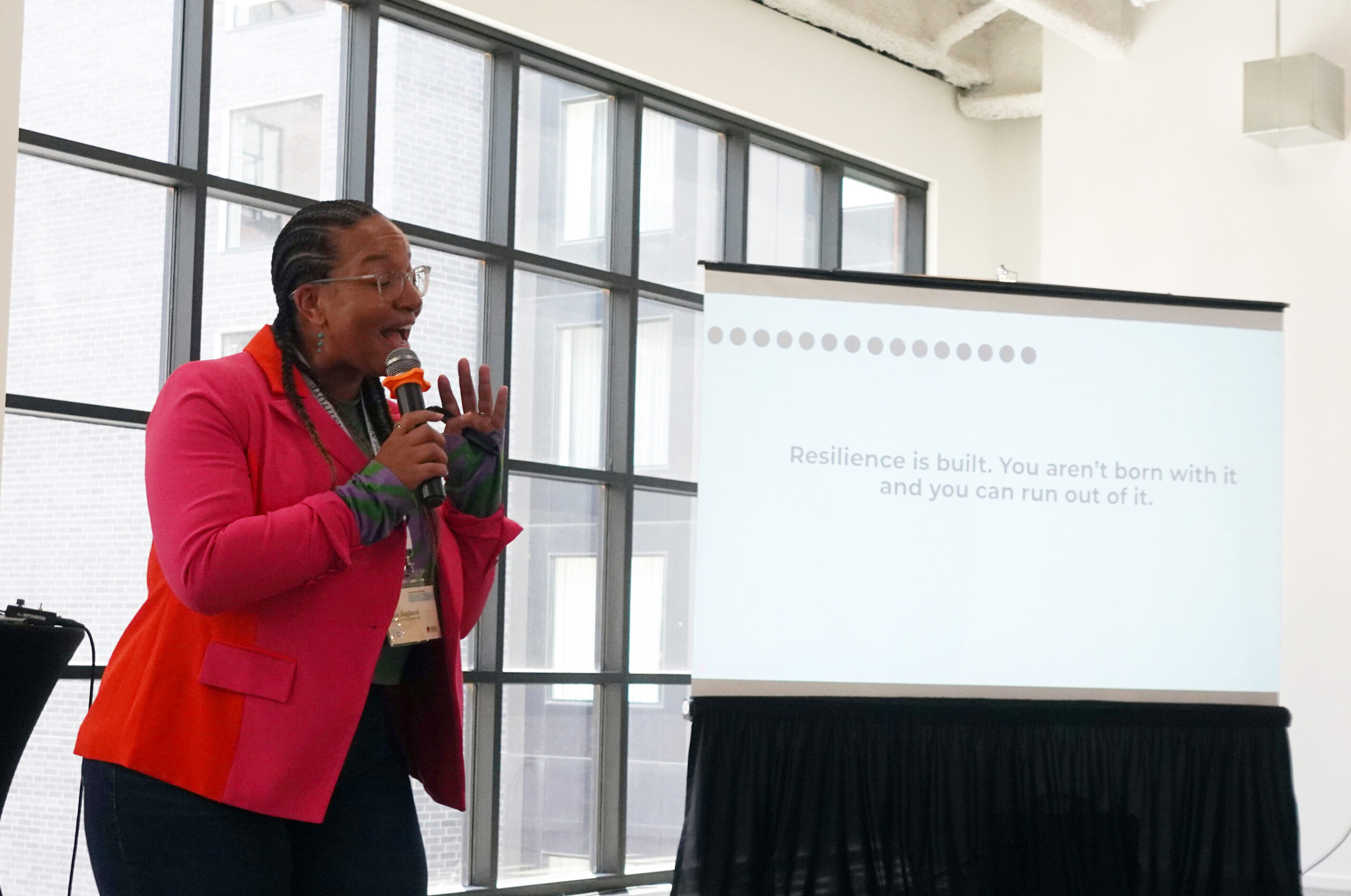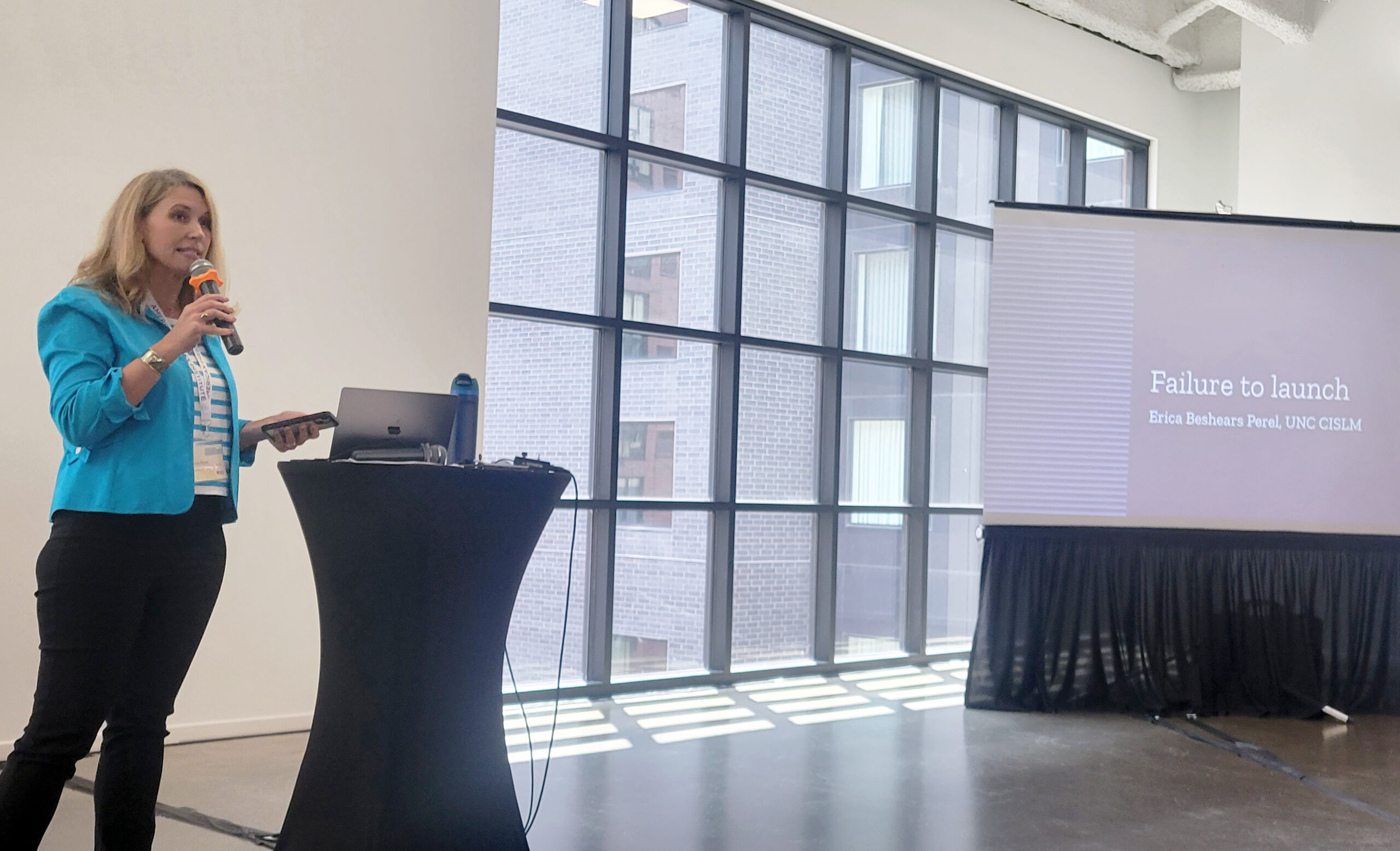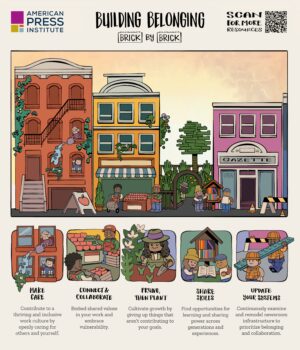How to build resilience for yourself and your news organization
Caitlin Dewey, for API's Better News,
Samantha Ragland, vice president of Journalism Programs at the American Press Institute, speaks about how resilience is built over time at the API Local News Summit in July 2024 in Minneapolis. (Photo by Jan Ross Sakian/American Press Institute)
Three news leaders share how they turned high-stakes failures into successes.This is a series on Better News to a) showcase innovative/experimental ideas that emerge from the Knight-Lenfest Newsroom Initiative and b) share replicable tactics that benefit the news industry as a whole.
This piece features tips from Joel Christopher, the executive editor of the Knox News; Erica Beshears Perel, the director of UNC’s Center for Innovation and Sustainability in Local Media; and Samantha Ragland, API’s vice president of journalism programs. Christoper and Knox News participated in the UNC Table Stakes program in 2020-21 and 2022-23, and Perel was the director of the UNC Table Stakes program and participated in 2018-19 when she was with the Daily Tar Heel. Christopher, Beshears Perel and Ragland all participated in the API Local News Summit for Table Stakes Alumni, focused on fostering belonging and collaboration in July 2024 in Minneapolis, which is where they shared these stories and tips.
In 2021, Tennessee’s Knox News launched an ambitious project to rebuild trust with the Black community. For decades, staff realized, the paper had failed to include voices from Knoxvillians of color, and often downplayed or tokenized their stories.
To begin to address that historic neglect, executive editor Joel Christopher and his staff launched an audience engagement initiative that offered free subscriptions to readers of color and invited them to join a private Facebook group where they could share story ideas and feedback on Knox News’ coverage. Christopher hoped the group would foster new relationships and help the paper change some entrenched patterns.
After a strong start, however, Black readers started dropping out of the Facebook group. Maintaining that community sometimes felt like one more thing that overworked reporters had to do.
“When you’ve spent generations not doing something right, you don’t fix it overnight,” Christopher said. He faced the sort of stressful, high-stakes situation that every news leader dreads: A major initiative had failed visibly, and he needed to salvage it.
But while such failures can seem discouraging or insurmountable in the moment, they’re also the key to long-term success. Lessons learned from failures inform better solutions. And recovering from failure builds individual and organizational resilience.
“If you aim to be a resilient journalist and person, you have to be comfortable with failure,” said Samantha Ragland, API’s vice president of journalism programs. “Resilience is built. You aren’t born with it, and you can run out of it.”
Fail, reflect, pivot
Resilience is a trendy topic at large corporations and business schools, where researchers have found that it can be learned, much like any skill. People often think of resilience as an inherent quality that shields them from change and stress. But that’s a misunderstanding, Ragland said: Resilience is actually the byproduct of “productive stress,” like the kind you get when you try something new … and maybe don’t succeed at it.
“Productive stress” has three components, Ragland explained. It is:
- Predictable: You know what to expect
- Moderate: You know the intensity and duration, and
- Controllable: You know when to stop and walk away (and you’re empowered to do that)
Repeat exposure to low or moderate levels of productive stress can make you more resilient over time, much like endurance training helps athletes build up their stamina. Crucially, athletes also rest and recover between workouts, which is equally important for nurturing resilient employees and leaders.
Resilient people do still fail, after all. But they take the time to step back, evaluate what they’re doing and make changes based on those real-time lessons. Resilience, you might say, is a three-step process: fail, reflect, pivot.
“Every time you take on something new, you have to know when to stop and recover,” Ragland said. “Do the work, then step outside the work to see how it went.”

Joel Christoper, editor of Knox News, shares his story of failure and resilience at the API Local News Summit in July 2024 in Minneapolis. (Photo by Jan Ross Sakian/American Press Institute)
Righting a failed engagement project
In Knoxville, that’s exactly what Knox News did. On reflection, Christopher said, he and his staff realized that the Facebook group wasn’t working because it failed to build authentic, lasting relationships.
To do that, the news organization needed to move offline and engage more deeply with Black institutions and community leaders. It has since partnered on a series of community forums with the Beck Cultural Exchange Center, a nonprofit organization and museum that preserves and celebrates Black history and culture. At one recent event, a nine-person panel included community organizers, activists, Knox News journalists and people who had experienced excessive force firsthand. The panel discussed policing and accountability in the region.
“We’ve started to rebuild some of those relationships now,” Christopher said.
Learn more: Resources on community engagement

Erica Beshears Perel shares lessons from a failed partnership at the API Local News Summit in July 2024 in Minneapolis. (Photo by Jan Ross Sakian/American Press Institute)
Revising a partnership strategy
Not all pivots are quite so public. In 2018 and 2019, The Daily Tar Heel — the independent student newspaper of the University of North Carolina at Chapel Hill — realized that its partnership with a buzzy online events startup wasn’t working as planned, said Erica Beshears Perel, the former general manager of DTH Media Corp, which publishes The Daily Tar Heel, and the current director of UNC’s Center for Innovation and Sustainability in Local Media.
Under the partnership, the startup gave the Tar Heel free access to its calendar and event listing technology in exchange for content. The Tar Heel spun up a newsletter to support the collaboration and planned to sell ads against it. But the big launch day came and went … and the partnership attracted little attention, from advertisers or anyone else.
“It never yielded benefits to either party,” Beshears Perel said. In the aftermath, she reflected on what makes a good collaboration — and developed an internal scorecard that The Daily Tar Heel now uses to evaluate potential partnerships. Among other questions, the scorecard asks if the partnership furthers the paper’s core mission and if it provides opportunities for students. This particular initiative may have failed, but the organization is more resilient.
Learn more: A primer on news partnerships & collaborations
Reconnecting with a disengaged employee
Ragland of API knows this type of pivot well. When she became the manager of digital storytelling at the Palm Beach Post in 2018, she absorbed a legacy team from the paper … including its former editor, now a reporter. Ragland’s relationship with that reporter was difficult, she said. He disengaged from the team, while she avoided managing him because she felt intimidated — a classic management failure.
On reflection, however, Ragland realized that communicating more deeply and empathetically with this reporter could help bridge the gap between them and help address some of the anxieties the reorganization created. The two began meeting one-on-one monthly, which made a big difference in their relationship. The new team also sat down to discuss the reorganization and the group’s shared vision for success, which included leveraging institutional knowledge, personal interests and newsletter strategy to build new products.
“The team decided the culture we wanted to live by, and that was one of collaboration and continuing education,” Ragland said.
Tips and tools for building resilience
- Prioritize rest and reflection. “If you don’t learn to strategically stop doing what you’re doing and recover, then your resilience will run dry and you’ll get used to running on empty,” Ragland said.
- Embrace the retrospective. “Look-back meetings” provide a structured opportunity to step away from past projects, compile lessons and put those learnings into action.
- Learn to stifle counterproductive thinking at the source. It’s easy to give in to despair or self-doubt amid failure or other stress. “Real-time resilience” is a strategy designed to help rewrite your inner script.
